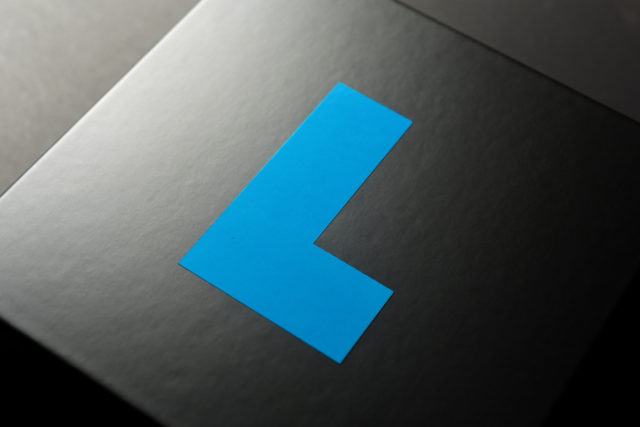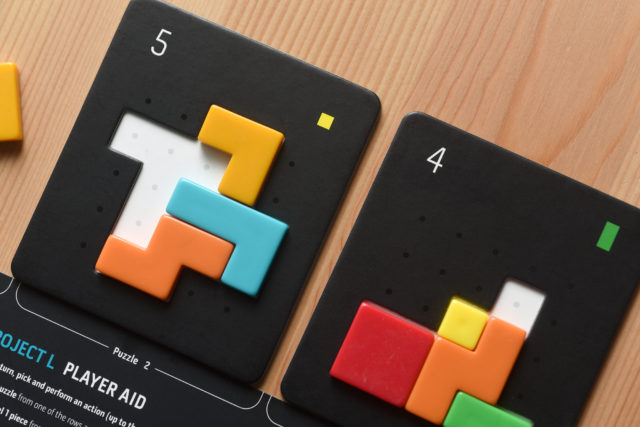I am always on the lookout for games that I think will be a big hit with my family. I come from a family of gamers. It’s the reason I play so much today. However, as my hobby has morphed into an obsession and eventually a profession, the games I tend to gravitate to are a bit more complex than the Euchre, Yahtzee, and Cribbage of my youth. That is not to say I don’t still love and play those games. Often simple rules and fun decisions are just what I’m looking for.
On a recent trip home, I pulled out the beautiful Project L. I hadn’t played it yet and sitting down with my folks seemed the right time to try it.

The rules of Project L are quite simple. You are collecting and upgrading polyomino tiles and using them to fill in a series of different puzzles. Completing a puzzle earns you a free tile and possible some points depending on the complexity or size of the puzzle you just completed.
You start with a measly supply of a Level 1 and a Level 2 tile. A set of four face up white puzzles and four face up black tiles make up the display.
On a turn, you have three actions to spend. You can take a new puzzle (easier white ones or more difficult black ones). You can be working on up to four at a time. You can take a Level 1 tile, which is just a single square, not great at covering a lot of your puzzle quickly, but useful to fill small holes. You can upgrade a tile one level, There are four levels of tiles (five with certain variants). Each time you upgrade a tile, you move one level up taking the tile of your choice from the supply. You can place a tile on one of the puzzles you’re working on. Finally, if you have the tiles and the openings you can perform a Master Action once per turn. This allows you to place one tile on each of your puzzles. Boy howdy that’s satisfying.

As you complete puzzles, you add them to your scoring pile and take the reward of a free tile (indicated on the puzzle itself). This offers a shortcut to improving your supply of tiles. Many of of the white puzzles offer no reward in points, but will allow you to gain new tiles quickly, allowing you to attack some of the more valuable puzzles with a better arsenal.
Play continues until the black puzzles deck runs out. That triggers game end and everyone gets one more turn. After the final round, everyone can perform final touches on their puzzles, completing them if possible, however they lose one point for each tile they add in this way. Then you simply add the points on your puzzles and the highest points wins. In case of a tie, the most puzzles and then the most tiles breaks it.
Project L is exceedingly simple and almost cathartic in its execution. Besides stealing a puzzle you might have had your eye on in the display, there’s no direct competition between players. You’re all working to solve your own puzzles as quickly as possible. When is the right time to upgrade a tile? When should you go for a more difficult puzzle? Is now the right time to trigger game end? These are the things you’ll think about when playing, but really your mind is more occupied with the satisfying challenge of completing your personal puzzles.

There are variants to play that you can add to the game for a bit more complexity. The Ghost Piece expansion allows you to form special Level 5 tiles in your puzzles and take the reward of two or more Level 1-4 tiles that form the Ghost Piece shape. The Ambassador expansion adds puzzles marked with an ‘M’. They don’t give you an immediate benefit when completed, but you can spend them on your turn like Master Actions. The only difference is that there’s no limit to them. There is a solo mode as well, which makes sense. A lot of what you’re doing in the game is solving your own puzzle. You should be able to play it on your own.
I find Project L to be a strikingly beautiful game. From the minimalist aesthetics, to the colourful tiles, to the simplicity of the gameplay. Rounds last around a half hour, but they never overstay their welcome. When one game ends, you kind of want to play again immediately.
I mentioned that I pulled this out with my folks one weekend and I think we ended up playing around seven times over a couple days and with various family members. It was a huge hit and one that I will surely bring again. Another friend that played Project L mentioned that he worried it would feel bit samey after awhile, and I could see that. However, with lots of different ways to play and, in my opinion, other ways to expand on the base game, I don’t think that would be a big concern of mine.
I highly recommend checking out Project L.
A media copy of Project L was provided by Boardcubator for this article.
Comments
No comments yet! Be the first!